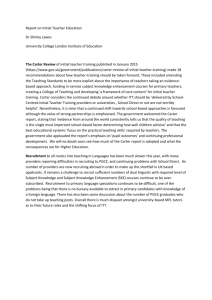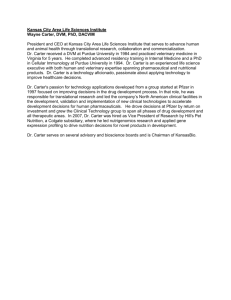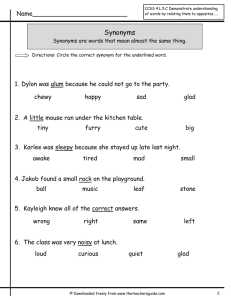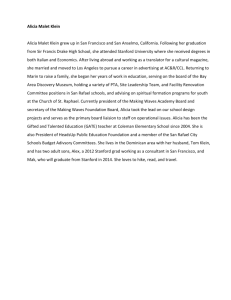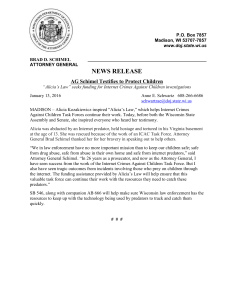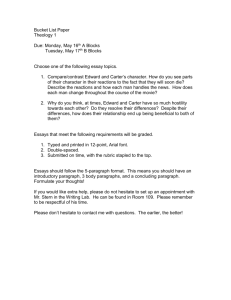Animal Classification
advertisement
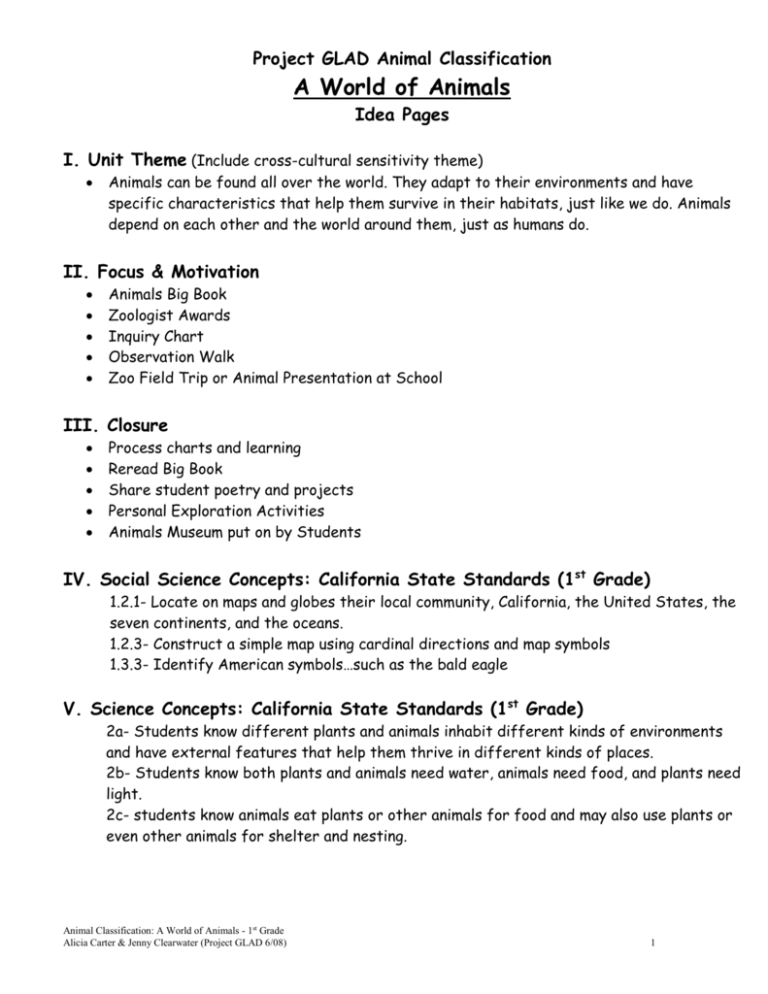
Project GLAD Animal Classification A World of Animals Idea Pages I. Unit Theme (Include cross-cultural sensitivity theme) Animals can be found all over the world. They adapt to their environments and have specific characteristics that help them survive in their habitats, just like we do. Animals depend on each other and the world around them, just as humans do. II. Focus & Motivation Animals Big Book Zoologist Awards Inquiry Chart Observation Walk Zoo Field Trip or Animal Presentation at School III. Closure Process charts and learning Reread Big Book Share student poetry and projects Personal Exploration Activities Animals Museum put on by Students IV. Social Science Concepts: California State Standards (1st Grade) 1.2.1- Locate on maps and globes their local community, California, the United States, the seven continents, and the oceans. 1.2.3- Construct a simple map using cardinal directions and map symbols 1.3.3- Identify American symbols…such as the bald eagle V. Science Concepts: California State Standards (1st Grade) 2a- Students know different plants and animals inhabit different kinds of environments and have external features that help them thrive in different kinds of places. 2b- Students know both plants and animals need water, animals need food, and plants need light. 2c- students know animals eat plants or other animals for food and may also use plants or even other animals for shelter and nesting. Animal Classification: A World of Animals - 1st Grade Alicia Carter & Jenny Clearwater (Project GLAD 6/08) 1 IDEA PAGES 2 2d- Students know how to infer what animals eat from the shapes of their teeth (e.g., sharp teeth: eats meat; flat teeth: eats plants). 4a- Draw pictures that portray some features of the thing being described. 4d- Describe the relative position of two objects by using two references (e.g. above and next to, below and left of). VI. Language Arts Concepts: California State Standards (1st Grade) Reading 1.1- Match oral words to printed words. 1.2- Identify the title and author of a reading selection. 1.3- Identify letters, words, and sentences. 1.4- Distinguish initial, medial, and final sounds in single-syllable words. 1.5- Distinguish long- and short-vowel sounds in orally stated single-syllable words. 1.6- Create and state a series of rhyming words, including consonant blends. 1.7- Add, delete, or change target sounds to change words. 1.8- Blend two to four phonemes into recognizable words. 1.9- Segment single syllable words into their components. 1.10- Generate the sounds from all the letters and letter patterns, including consonant blends and long- and short-vowel patterns, and blend those sounds into recognizable words. 1.11- Read common irregular sight words. 1.12- Use knowledge of vowel digraphs and r-controlled letter-sound associations to read words. 1.13- Read compound words and contractions. 1.14- Read inflectional forms (e.g. –s, -ed, -ing) and root words (e.g. look, looked, looking). 1.15- Read common word families. 1.16- Read aloud with fluency in a manner that sounds like natural speech. 1.17- Classify grade-appropriate categories of words (e.g. concrete collections of animals, foods, toys). 2.1- Identify text that uses sequence or other logical order. 2.2- Respond to who, what, when, where, and how questions. 2.3- Follow one-step written instructions. 2.4- Use context to resolve ambiguities about words and sentence meanings. 2.5- Confirm predictions about what will happen next in a text by identifying key words. 2.6- Relate prior knowledge to textual information. 2.7- Retell the central ideas of simple expository or narrative passages. Animal Classification: A World of Animals - 1st Grade Alicia Carter & Jenny Clearwater (Project GLAD 6/08) 2 IDEA PAGES 3 3.1- Identify and describe the elements of plot, setting, and character(s) in a story, as well as the story’s beginning, middle, and ending. 3.2- Describe the roles of authors and illustrators and their contributions to print materials. Writing 1.1- Select a focus when writing. 1.2- Use descriptive words when writing. 1.3- Print legibly and space letters, words, and sentences appropriately. 2.2- Write brief expository descriptions of a real object, person, place, or event, using sensory details. Written and Oral Language Conventions 1.1- Write and speak in complete, coherent sentences. 1.2- Identify and correctly use singular and plural nouns. 1.3- Identify and correctly use contractions and singular possessive pronouns in writing and speaking (isn’t, aren’t, can’t, won’t, my/mine, his/hers, yours). 1.4- Distinguish between declarative, exclamatory, and interrogative sentences. 1.5- Use a period, exclamation point, or question mark at the end of sentences. 1.6- Use knowledge of the basic rules of punctuation and capitalization when writing. 1.7- Capitalize the first word of a sentence, names of people, and the pronoun I. 1.8- Spell three- and four-letter short-vowel words and grade-level appropriate sight words correctly. Listening and Speaking 1.1- Listen attentively. 1.2- Ask questions for clarification and understanding. 1.3- Give, restate, and follow simple two-step directions. 1.4- Stay on the topic when speaking. 1.5- Use descriptive words when speaking about people, places, things, and events. VII.ELD Concepts: California State Standards (1st Grade) LS=Listening & Speaking WA= Word Analysis Animal Classification: A World of Animals - 1st Grade Alicia Carter & Jenny Clearwater (Project GLAD 6/08) RF/VD= Reading Fluency & Vocabulary Dev. RC= Reading Comprehension LRA= Literary Response & Analysis W= Writing & English Language Conventions 3 IDEA PAGES 4 Beginning LS- Begin to speak a few words or sentences by using some English phonemes and rudimentary English grammatical forms (e.g., single words or phrases). LS- Answer simple questions with one- to two-word responses. LS- Respond to simple directions and questions by using physical actions and other means of nonverbal communication (e.g., matching objects, pointing to an answer, drawing pictures). LS- Independently use common social greetings and simple repetitive phrases (e.g., “Thank you,” “You’re Welcome”). WA- Recognize English phonemes that correspond to phonemes students already hear and produce in their primary language. RF/VD- Read aloud simple words (e.g., nouns and adjectives) in stories or games. RF/VD- Respond appropriately to some social and academic interactions (e.g., simple question/answer, negotiate play). RF/VD- Demonstrate comprehension of simple vocabulary with an appropriate action. RF/VD- Retell simple stories by using drawings, words, or phrases. RF/VD- Produce simple vocabulary (single words or short phrases) to communicate basic needs in social and academic settings (e.g., locations, greeting, classroom objects). RC- Respond orally to stories read aloud, using physical actions and other means of nonverbal communication (e.g., match objects, pointing to an answer, drawing pictures). RC- Respond orally to stories read aloud giving one- or two-word responses to factual comprehension questions. RC- Draw pictures from one’s own experience related to a story or topic. RC- Understand and follow simple one-step directions for classroom activities. RC- Identify, using key words or pictures, the basic sequence of events in stories read aloud. LRA- Listen to a story and respond orally in one or two words to factual comprehension questions. LRA- Draw pictures related to a work of literature identifying setting and characters. W- Copy words posted and commonly used in the classroom. W- Write a few words or phrases about an event or character from a story read by the teacher. W- Write a phrase or simple sentence about an experience generated from a group story. W- Use capitalization when writing one’s own name. Animal Classification: A World of Animals - 1st Grade Alicia Carter & Jenny Clearwater (Project GLAD 6/08) 4 IDEA PAGES 5 Early Intermediate LS- Begin to be understood when speaking but may have some inconsistent use of standard English grammatical forms and sounds (e.g., plurals, simple past tense, pronouns such as he and she). LS- Ask and answer questions by using phrases or simple sentences. LS- Retell familiar stories and short conversations by using appropriate gestures, expressions, and illustrative objects. LS- Orally communicate basic needs. LS- Recite familiar rhymes, songs, and simple stories. WA- Produce English phonemes that correspond to phonemes students already hear and produce, including long and short vowels and initial and final consonants. WA- Recognize English phonemes that do not correspond to sounds students hear and produce. RF/VD- Produce vocabulary, phrases, and simple sentences to communicate basic needs in social and academic settings. RF/VD- Read simple vocabulary, phrases, and sentences independently. RF/VD- Read aloud an increasing number of English words. RF/VD- Demonstrate internalization of English grammar, usage, and word choice by recognizing and correcting some errors when speaking or reading aloud. RC- Respond orally to simple stories read aloud using phrases or simple sentences to answer factual comprehension questions. RC- Draw and label pictures related to a story topic or one’s own experience. RC- Understand and follow simple two-step directions for classroom activities. RC- Orally identify, using key words or phrases, the basic sequence of event in text read aloud. RC- Draw logical inferences from a story read aloud. LRA- Respond orally to factual comprehension questions about stories by answering in simple sentences. LRA- Recite simple poems. LRA- Identify orally the setting and characters by using simple sentences and vocabulary. W- Write simple sentences about events or characters from familiar stories read aloud by the teacher. W- Write simple sentences by using key words posted and commonly used in the classroom. W- Write one to two simple sentences. Animal Classification: A World of Animals - 1st Grade Alicia Carter & Jenny Clearwater (Project GLAD 6/08) 5 IDEA PAGES 6 W- Use capitalization to begin sentences and for proper nouns. W- Use a period or question mark at the end of a sentence. W- Edit writing for basic conventions (e.g., capitalization and use of periods) and make some corrections. Intermediate LS- Ask and answer instructional questions by using simple sentences. LS- Listen attentively to stories and information and identify important details and concepts by using both verbal and nonverbal responses. LS- Make oneself understood when speaking by using consistent standard English grammatical forms and sounds; however, some rules may not be followed (e.g., thirdperson singular, male and female pronouns). LS- Participate in social conversations with peers and adults on familiar topics by asking and answering questions and soliciting information. LS- Retell stories and talk about school-related activities by using expanded vocabulary, descriptive words, and paraphrasing. WA- Produce most English phonemes correctly while reading aloud. WA- Recognize sound/symbol relationships and basic word-formation rules in phrases, simple sentences, or simple text. WA- Recognize and name all uppercase and lowercase letters of the alphabet. RF/VD- Demonstrate internalization of English grammar, usage, and word choice by recognizing and correcting some errors when speaking or reading aloud. RF/VD- Use decoding skills to read more complex words independently. RF/VD- Use more complex vocabulary and sentences to communicate needs and express ideas in a wider variety of social and academic settings (e.g., classroom discussions, mediation of conflicts). RF/VD- Apply knowledge of content-related vocabulary to discussions and reading. RF/VD- Recognize simple prefixes and suffixes when they are attached to known vocabulary. RC- Read stories and respond orally in simple sentences to factual comprehension questions about the stories. RC- While reading aloud in a group, point out basic text features such as the title, table of contents and chapter headings. RC- Draw inferences about stories read aloud and use simple phrases or sentences to communicate the inferences. RC- Write captions or phrases for drawings related to a story. RC- Understand and follow some multiple-step directions for classroom-related activities. Animal Classification: A World of Animals - 1st Grade Alicia Carter & Jenny Clearwater (Project GLAD 6/08) 6 IDEA PAGES 7 LRA- Use expanded vocabulary and descriptive words in oral and written responses to simple texts. LRA- Read simple poetry and use simple sentences in answering factual comprehension questions. W- Write short narrative stories that include the elements of setting and characters. W- Produce independent writing that is understood when read but may include inconsistent use of standard grammatical forms. W- Following a model, proceed through the writing process to independently write short paragraphs of at least three lines. W- Write simple sentences appropriate for language arts and other content areas. W- Write a friendly letter of a few lines. W- Produce independent writing that may include some inconsistent use of capitalization, periods, and correct spelling. W- Use standard word order but may have some inconsistent grammatical forms (e.g., subject/verb without inflections). Early Advanced LS- Listen attentively to stories and information and orally identify key details and concepts. LS- Retell stories in greater detail by including the characters, setting, and plot. LS- Make oneself understood when speaking by using consistent standard English grammatical forms, sounds, intonation, pitch, and modulation, but may make random errors. LS- Participate in and initiate more extended social conversations with peers and adults on unfamiliar topics by asking and answering questions and restating and soliciting information. LS- Recognize appropriate ways of speaking that vary according to the purpose, audience, and subject matter. LS- Ask and answer instructional questions with more extensive supporting elements (e.g., “Which part of the story was the most important?”). WA- Use common English morphemes to derive meaning in oral and silent reading (e.g., basic syllabication rules, regular and irregular plurals, and basic phonics). WA- Recognize sound/symbol relationships and basic word-formation rules in phrases, simple sentences, or simple text. RF/VD- Recognize simple antonyms and synonyms in stories or games. RF/VD- Use simple prefixes and suffixes when they are attached to known vocabulary. RF/VD- Use decoding skills and knowledge of academic and social vocabulary to begin independent reading. Animal Classification: A World of Animals - 1st Grade Alicia Carter & Jenny Clearwater (Project GLAD 6/08) 7 IDEA PAGES 8 RC- Read text and use detailed sentences to identify orally the main idea and use the idea to draw inferences about the text. RC- Read stories and orally respond to them by answering factual comprehension questions about cause-and-effect relationships. RC- Write a brief summary (three or four complete sentences) of a story. RC- Read stories and texts from content areas and respond orally to them by restating facts and details to clarify ideas. LRA- Read short poems and orally identify the basic elements (e.g., rhythm and rhyme). LRA- Read a literary selection and orally identify the literary elements of plot, setting, and characters. LRA- Read a story and identify the beginning, middle, and end. W- Write short narratives that include elements of setting, characters, and events. W- Proceed through the writing process to write short paragraphs that maintain a consistent focus. W- Use complex vocabulary and sentences appropriate for language arts and other content areas. W- Produce independent writing with consistent use of standard grammatical forms (some rules may not be followed). W- Produce independent writing that may include some periods, correct spelling, and inconsistent capitalization. W- Use standard word order with some inconsistent grammar forms (e.g., subject/verb agreement). W- Edit writing to check some of the mechanics of writing (e.g., capitalization and periods). Advanced LS- Listen attentively to stories and information on new topics and identify both orally and in writing key details and concepts. LS- Demonstrate an understanding of idiomatic expressions (e.g., “Give me a hand.”) by responding to such expressions and using them appropriately. LS- Negotiate and initiate social conversations by questioning, restating, soliciting information, and paraphrasing the communication of others. LS- Consistently use appropriate ways of speaking and writing that vary according to the purpose, audience, and subject matter. LS- Narrate and paraphrase events in grater detail by using more extended vocabulary. LS- Speak clearly and comprehensibly by using standard English grammatical forms, sounds, intonation, pitch, and modulation. Animal Classification: A World of Animals - 1st Grade Alicia Carter & Jenny Clearwater (Project GLAD 6/08) 8 IDEA PAGES 9 WA- Apply knowledge of common morphemes to derive meaning in oral and silent reading (e.g., basic syllabication rules, regular and irregular plurals, and basic phonics). RF/VD- Explain common antonyms and synonyms. RF/VD- Recognize words that have multiple meanings in texts. RF/VD- Apply knowledge of academic and social vocabulary to achieve independent reading. RF/VD- Read aloud with appropriate pacing, intonation, and expression narrative and expository texts. RC- Prepare and oral or a written summary by using various comprehension strategies with literature and content area texts. RC- Locate and use text features, such as the title, table of contents, chapter headings, diagrams, and index. LRA- Read a variety of children’s literature and respond to it both orally and in writing. LRA- Describe the elements of poetry (e.g., rhythm, rhyme, alliteration). LRA- Compare and contrast different authors’ use of literary elements. W- Write short narratives that include examples of writing appropriate for language arts and other content areas. W- Write short narratives that describe the setting, characters, objects, and events. W- Produce independent writing by using correct grammatical forms. W- Proceed through the writing process to write clear and coherent sentences and paragraphs that maintain a consistent focus. W- Use complete sentences and correct word order. W- Use correct parts of speech, including correct subject/verb agreement. W- Edit for punctuation, capitalization, and spelling. W- Produce writing that demonstrates a command of the conventions of standard English. VIII. Vocabulary (1st Grade) symbol continent ocean north south east west habitat external Animal Classification: A World of Animals - 1st Grade Alicia Carter & Jenny Clearwater (Project GLAD 6/08) internal characteristic shelter diet carnivore herbivore omnivore feature zoologist vertebrate invertebrate amphibian reptile mammal bird fish cooperation 9 IDEA PAGES 10 IX. Resources and Materials (1st Grade) Teacher -Science Textbook Series -Literature Textbook Series -Are You My Mother?, P.D. Eastman -The Important Book, Margaret Wise Brown -Google Images (www.google.com) Fiction -The Eagle and the Wren, Jane Goodall -Bald Eagle, Gordon Morrison -Fly Eagle, Fly: An African Tale, Desmond Tutu Nonfiction -Vertebrates (What is an Animal?), Ted O’Hare -Kingfisher Animal Encyclopedia, John Farndon & Jon Kirkwood -Sharkabet: A Sea of Sharks from A to Z, Ray Troll -The Bald Eagle, Lloyd G. Douglas -The Bald Eagle, Judith Jango-Cohen -The Bald Eagle Returns, Dorothy Henshaw Patent -Three River Junction: A Story of an Alaskan Bald Eagle Preserve, Sarann D. Burnham Poetry -Eagle Poems Online (www.baldeagleinfo.com/eagle/poems.html) -Mites to Mastodons: A Book of Animal Poems, Maxine Kumin & Pamela Zagarenski -Alphabestiary: Animal Poems from A to Z, Jane Yolen & Allan Eitzen Technology -Animal Alphabet Online (www.nps.gov/archive/yell/kidstuff/Alphabet/) -Enchanted Learning (www.enchantedlearning.com) -Bald Eagles (www.baldeagleinfo.com) -Bald Eagles (www.eagles.org) -Vertebrates (www.kidport.com/RefLib/Science/Animals/AnimalIndexV.htm) -Bald Eagle for Kids (http://ccb-wm.org/eaglevideo_kids/eaglevideo_kids_home.htm) Animal Classification: A World of Animals - 1st Grade Alicia Carter & Jenny Clearwater (Project GLAD 6/08) 10 Project GLAD A World of Animals Unit Planning Pages I. Focus & Motivation Cognitive Content Dictionary (CCD) with Signal Word Animals Big Book Picture File Cards Observation Walk Zoologist Awards Poetry Chants Inquiry Chart Realia & Interest Pieces II. Input 10/2 Lecture with Primary Language World Map Pictorial (continents, oceans, cardinal directions) Pictorial Input Chart- Zoologist Graphic Organizer- Vertebrates & Invertebrates Pictorial Input Chart- Teeth and What They Do Pictorial Input Chart- the Bald Eagle Narrative Input- Are You My Mother? (adaptation) III. Guided Oral Practice-Form Co-op groups T-graph & processing Exploration Report (with Picture File Cards) Numbered Heads Heads Together & Process Grid Sentence Patterning Chart Team Tasks Group Frame Animal Classification: A World of Animals - 1st Grade Alicia Carter & Jenny Clearwater (Project GLAD 6/08) 11 PLANNING PAGES 2 IV. Reading & Writing A. Whole Group Group Frames Animals Big Book Cooperative Strip Paragraph Found Poem Letter to Baldy (follow-up to Narrative Input) B. Small Group Team Tasks Ear-to-Ear Reading Textbook Work: paired reading, tutoring, activity sheets Focused Reading Flexible Reading Groups Expert Groups Team Writers’ Workshop Group Process Grids Sentence Patterning Chart (Farmer in the Dell) Interactive Reading C. Individual Activities--Portfolio Paragraph Writing Poetry Writing World Map Zoologist Pictorial Vertebrates/Invertebrates Graphic Organizer Bald Eagle Pictorial Story Map (Narrative Input) Interactive Journal Learning Logs Letter to Baldy Animal Classification: A World of Animals - 1st Grade Alicia Carter & Jenny Clearwater (Project GLAD 6/08) 12 PLANNING PAGES 3 D. Writers’ Workshop Mini Lesson Writing & Planning Conferences Author’s Chair Completion of expository, narrative, and poetry pieces V. Reinforcement & Extension Activities Poetry Read Aloud Newspaper Interest Pieces Environmental Study- Taking action in the community Total Room Environment Cooperative Project- Animal Museum VI. Daily Activities Read Aloud Silent Reading or Book Sharing Listening Activities Oral Language Activities Daily News or Interest Piece Personal Interaction VII. Closure Focused Reading Process Inquiry Charts Sharing Poetry Reading Big Books Student Generated Text Personal Exploration Activity Animal Classification: A World of Animals - 1st Grade Alicia Carter & Jenny Clearwater (Project GLAD 6/08) 13 A World of Animals First Grade Sample Daily Lesson Plan Day 1: Focus & Motivation Personal Standards: Set Expectations Signal Word - Zoologist Observation Charts Inquiry Chart - Animals Teacher-Made Big Book - The Important Thing About Animals Picture File Cards - Exploration Report Input Pictorial Input Chart - World Map (continents, oceans, cardinal directions) Pictorial Input Chart - Zoologist 10/2 with primary language Guided Oral Practice Poetry- “Zoologist BUGALOO” T-Graph For Social Skills-Cooperation Team Points Input Graphic Organizer- Vertebrates & Invertebrates 10/2 with primary language Poetry - “Is it a Vertebrate?” Reading & Writing Learning Log Interactive Journals Closure Home/School Connection Review Chants Animal Classification: A World of Animals - 1st Grade Alicia Carter & Jenny Clearwater (Project GLAD 6/08) 14 Project GLAD A World of Animals Sample Daily Lesson Plan Day 2: Focus & Motivation Signal Word- carnivore Process Home/School Connection Review Input with Word Cards Poetry - “Continents & Oceans” Input Pictorial Input Chart-eagle 10/2 with primary language Guided Oral Practice Poetry - “I Know an Eagle” Expert Groups (1-2) Team Tasks Input Pictorial Input Chart - Teeth & What They Do 10/2 with primary language Poetry -“Teeth & What They Do” Reading & Writing Interactive Journals Writers’ Workshop - Mini Lesson - Writing - Authors’ Chair Closure Process Inquiry Chart Home/School Connection Review Chants Animal Classification: A World of Animals - 1st Grade Alicia Carter & Jenny Clearwater (Project GLAD 6/08) 15 Project GLAD A World of Animals Sample Daily Lesson Plan Day 3: Focus & Motivation Signal Word - characteristic Process Home/School Connection Review Input (including Narrative) with Word Cards/Highlight Poetry Review Chants & Big Book Input Narrative Input - Are You My Mother? Guided Oral Practice Expert Groups (Finish) Team Tasks - Team Evaluation (from T-Graph) & Team Point Farmer In the Dell/Sentence Patterning Chart - Reading Game - Trading Game - Here/There Flip Chant Experts Teach Teams Process Grid Team Points (from goal taken from t-graph) Reading & Writing Interactive Journals Closure Process Inquiry Chart Review Chants Animal Classification: A World of Animals - 1st Grade Alicia Carter & Jenny Clearwater (Project GLAD 6/08) 16 Project GLAD A World of Animals Sample Daily Lesson Plan Day 4: Focus & Motivation Signal Word- Student Choice Process Home/School Connection Guided Oral Practice Review Pictorials/Chants (any left) with word cards/picture file cards Cooperative Strip Paragraph (Expository Descriptions) - Read, Revise, Edit Team Tasks Team Points (from goal taken from t-graph) Review Chants Reading & Writing Interactive Journals Story Map - Narrative Input Found Poem Guided Oral Practice Flexible Group Reading - Story Retell (Leveled ELD Group) Closure Process Big Book Animal Classification: A World of Animals - 1st Grade Alicia Carter & Jenny Clearwater (Project GLAD 6/08) 17 Project GLAD A World of Animals Sample Daily Lesson Plan Day 5: Focus & Motivation Signal Word- Student Choice Process Home/School Connection Picture Dictionary (introduce team task version) Guided Oral Practice Flexible Group Reading - Cooperative Strip Paragraph Review (Struggling Readers) - Reading Partners (at or above grade-level) Team Tasks Team Points (from goal taken from t-graph) Review Chants Reading & Writing Listen & Sketch Walk the Walls/Ear-to-Ear Reading Closure Team Presentations Team Trivia Game Zoologist Certificates Assessment Evaluate Week (letter home) Animal Classification: A World of Animals - 1st Grade Alicia Carter & Jenny Clearwater (Project GLAD 6/08) 18 Teeth and What They Do carnivore eats meat sharp, pointed teeth for tearing meat herbivore eats plants large, flat teeth for grinding plants omnivore eats meat & plants sharp, pointed teeth & large, flat teeth Animal Classification: A World of Animals - 1st Grade Alicia Carter & Jenny Clearwater (Project GLAD 6/08) 19 Big Book Text Cover: The Important Thing About Animals by Alicia Carter Title Page: The Important Thing About Animals by Alicia Carter C and C Publishers October 2006 Table of Contents: Animals Live on Continents Animals Live in Oceans Zoologists and Where They Work Zoologists and What They Study Vertebrates and Invertebrates Classification of Vertebrates Classification of Invertebrates Animals’ Teeth Animal Habitats Animals are Special 1 2 3 4 5 6 7 8 9 10 Page 1: The important thing about animals is that they are found all over the world. Animals can be found on every continent in the world. There are animals in North America. There are animals in South America. There are animals in Africa. There are animals in Europe. There are animals in Asia. There are animals in Australia. There are animals in Antarctica. But, the important thing about animals is that they are found all over the world. Animal Classification: A World of Animals - 1st Grade Alicia Carter & Jenny Clearwater (Project GLAD 6/08) 20 Page 2: The important thing about animals is that they are found all over the world. Animals can be found in every ocean in the world. There are animals in the Pacific Ocean. There are animals in the Atlantic Ocean. There are animals in the Indian Ocean. There are animals in the Arctic Ocean. There are animals in the Southern Ocean. But, the important thing about animals is that they are found all over the world. Page 3: The important thing about animals is that they are found all over the world. Zoologists are people who study animals. Zoologists work in aquariums. Zoologists work at zoos. Zoologists work in laboratories. Zoologists work outdoors. You can be a zoologist too! But, the important thing about animals is that they are found all over the world. Page 4: The important thing about animals is that they are found all over the world. Zoologists study animals to learn more about them. They study the animals’ classification, physical description, teeth, diet, habitat, and how they live. But, the important thing about animals is that they are found all over the world. Page 5: The important thing about animals is that they are found all over the world. Animals are classified, or put into groups, based on their characteristics, or what they look like. There are two main groups of animals: vertebrates and invertebrates. Vertebrates are animals with backbones. Invertebrates are animals without backbones. But, the important thing about animals is that they are found all over the world. Animal Classification: A World of Animals - 1st Grade Alicia Carter & Jenny Clearwater (Project GLAD 6/08) 21 Page 6: The important thing about animals is that they are found all over the world. Vertebrates are animals with backbones. There are five main groups, or families, of vertebrates. These groups are: fish amphibians reptiles birds mammals But, the important thing about animals is that they are found all over the world. Page 7: The important thing about animals is that they are found all over the world. Invertebrates are animals without backbones. There are seven main groups, or families, of invertebrates. They are: mollusks crustaceans insects arachnids poriferans protozoans cnidarians But, the important thing about animals is that they are found all over the world. Page 8: The important thing about animals is that they are found all over the world. Zoologists can tell a lot about animals by looking at their teeth. There are two main kinds of teeth. Animals with sharp, pointed teeth eat meat. They are called carnivores. Animals with larger, flat teeth eat plants. They are called herbivores. Animals with both kinds of teeth eat both meat and plants. They are called omnivores. But, the important thing about animals is that they are found all over the world. Animal Classification: A World of Animals - 1st Grade Alicia Carter & Jenny Clearwater (Project GLAD 6/08) 22 Page 9: The important thing about animals is that they are found all over the world. Animals live in different habitats. Some Some Some Some Some animals animals animals animals animals live live live live live in the mountains. in rivers. in ponds. in deserts. in oceans. But, the important thing about animals is that they are found all over the world. Page 10: The important thing about animals is that they are found all over the world. Animals are special. They need each other to live. They need us to live too and we need them. But, the important thing about animals is that they are found all over the world. Animal Classification: A World of Animals - 1st Grade Alicia Carter & Jenny Clearwater (Project GLAD 6/08) 23 Animal Classification: A World of Animals - 1st Grade Alicia Carter & Jenny Clearwater (Project GLAD 6/08) 24 Animal Classification: A World of Animals - 1st Grade Alicia Carter & Jenny Clearwater (Project GLAD 6/08) 25 Animal Classification: A World of Animals - 1st Grade Alicia Carter & Jenny Clearwater (Project GLAD 6/08) 26 Animal Classification: A World of Animals - 1st Grade Alicia Carter & Jenny Clearwater (Project GLAD 6/08) 27 Are You My Mother? adapted from P.D. Eastman Permission from Alicia Carter & Jenny Clearwater 1. One day, up in the beautiful, cool mountains, a baby eagle hatched from its egg. The eaglet was snug and warm in its cozy nest, way up high in a tree. Baldy, the baby eagle, was sad because he didn’t see his mother anywhere. Baldy decided that he would venture out into the world in order to search for his mother. He remembered that his mother had two wings, soft feathers, and a beak. 2. Baldy flew from the cool, snow-capped mountains down into the warm valley. He spied a clear, flowing river and decided to get a drink. In the river, he saw an interesting animal. “Are you my mother?” asked Baldy. “No, I belong to the fish group. I am a trout. I am a vertebrate like you; that means that we both have backbones. But I have fins and you have wings. I have scales and you have feathers. I am sorry, but I am not your mother,” replied the trout. Baldy got a cool drink of water and then continued his search for his mother. He remembered that his mother had two wings, soft feathers, and a beak. 3. Baldy then flew into a deep, dark forest where it was moist and damp. He spotted an interesting animal sitting on a lily pad in the pond. “Are you my mother?” Baldy asked the creature. “No, I am sorry,” replied the animal. “I am a vertebrate like you, but I belong to the amphibian group. I am a frog. I lead a double life; I started out living in water, and now I live on land. I had gills to be able to breathe under water, but now I have lungs so that I can breathe on land. You also have lungs in order to breathe. I have moist, smooth skin and you have feathers. I am sorry, but I am not your mother,” croaked the frog. Baldy was sad, but he continued looking for his mother. He remembered that his mother had two wings, soft feathers, and a beak. 4. Baldy flew from the deep, dark forest into the hot, sandy desert. He saw a juicy cactus and flew over to get a drink. Baldy spotted a tortoise slowly making its way across the desert. “Are you my mother?” inquired Baldy. “No, I belong to the reptile group. I am a tortoise. I am not as quick as my fellow reptiles, the snakes and lizards, but I am still a reptile. I have scaly, dry skin and you have feathers. I am cold-blooded and you are warm-blooded. I crawl and you fly. I am sorry, but I am not your mother,” sighed the tortoise. At this point, Baldy was ready to give up hope. He had traveled over the valley, beyond the forest, and through the desert in search of his mother. He remembered that his mother had two wings, soft feathers, and a beak. Animal Classification: A World of Animals - 1st Grade Alicia Carter & Jenny Clearwater (Project GLAD 6/08) 28 5. Baldy soared and soared until he reached a vast, beautiful, blue ocean. He swooped down from the sky as he spied water spraying up into the air. When the water cleared, Baldy saw an ENORMOUS, HUMONGOUS creature! “Are you my mother?” Baldy shouted. “No, I belong to the mammal family; I am a blue whale. I am the largest animal on earth! My babies are born live, and birds lay eggs. I have hair, and you have feathers. I have flippers, and you have wings. I am sorry, but I am not your mother,” spouted the whale, and she disappeared into the sea. Baldy began to cry; he missed his mother so much. He remembered that his mother had two wings, soft feathers, and a beak. 6. “Wake up! Wake up! It’s time to eat!” shrieked the mother eagle. Baldy opened his eyes and looked around. He was in his nice, safe eyrie. It had all been a bad dream after all! He looked up, and hovering above him was the most beautiful creature he had ever seen! She had two wings, soft feathers, and a beak. She was his mother! Animal Classification: A World of Animals - 1st Grade Alicia Carter & Jenny Clearwater (Project GLAD 6/08) 29 Zoology Poetry Booklet ____________________________________ Zoologist Animal Classification: A World of Animals - 1st Grade Alicia Carter & Jenny Clearwater (Project GLAD 6/08) 30 Continents and Oceans (Twinkle, Twinkle, Little Star) by Alicia Carter A continent’s a great big piece of land, The earth has seven on which we stand. Asia is the largest, Europe’s right beside, Africa is to the south, Australia is an island. North and South America take up the western side, Antarctica is very cold because it’s covered in ice. The rest of the earth is covered in oceans, Bodies of water that always are in motion. The Pacific is the largest, it’s name means ‘peace’, The Atlantic is much colder; it is very, very deep. The Indian is famous for monsoons and storms, The Arctic and the Southern are found near the poles. Animal Classification: A World of Animals - 1st Grade Alicia Carter & Jenny Clearwater (Project GLAD 6/08) 31 Zoologist BUGALOO by Alicia Carter I’m a zoologist and I’m here to say I study animals every day. Sometimes I investigate Sometimes I read a book Sometimes I go out in the world To take a closer look! Birds, fish, amphibians too, Reptiles, mammals…BUGALOO! I study classification of living things. Their teeth tell me a lot about what they eat. I learn how they adapt to their habitats. I know animals with backbones are vertebrates! Birds, fish, amphibians too, Reptiles, mammals…BUGALOO! Animal Classification: A World of Animals - 1st Grade Alicia Carter & Jenny Clearwater (Project GLAD 6/08) 32 Is It a Vertebrate? by Alicia Carter Is it a vertebrate? Is it a vertebrate? How do you know? And what else? What are some examples? And what else? Yes Ma’am! Yes Ma’am! It has a backbone. A skeleton inside. Birds, reptiles, fish! Amphibians and mammals! Is it an invertebrate? Is it an invertebrate? How do you know? And what else? What are some examples? And what else? Yes Ma’am! Yes Ma’am! It doesn’t have a backbone. Its insides are soft. Mollusks and crustaceans! Insects and arachnids! Animal Classification: A World of Animals - 1st Grade Alicia Carter & Jenny Clearwater (Project GLAD 6/08) 33 I Know an Eagle by Alicia Carter I know a bald eagle, A beautiful bald eagle, A beautiful bald eagle, That can soar through the sky. The eagle has soft feathers, Soft feathers and two wings, Soft feathers and two wings, And a very strong beak. I know a bald eagle, A beautiful bald eagle, A beautiful bald eagle, That can soar through the sky. The eagle has a nest, A nest called an eyrie, There’s an egg in the eyrie, That will hatch into an eaglet. I know a bald eagle, A beautiful bald eagle, A beautiful bald eagle, That can soar through the sky. The eagle is a symbol, A symbol of our freedom, A symbol of my country Called America. I know a bald eagle, A beautiful bald eagle, A beautiful bald eagle, That can soar through the sky. Animal Classification: A World of Animals - 1st Grade Alicia Carter & Jenny Clearwater (Project GLAD 6/08) 34 Classification Yes Ma’am by Alicia Carter Is it a fish? Is it a fish? How do you know? And what else? What are some examples? Yes Ma’am! Yes Ma’am! It has scales and a tail. It breathes with gills Trout, salmon, clownfish. Is it a bird? Is it a bird? How do you know? And what else? What are some examples? Yes Ma’am! Yes Ma’am! It has feathers and wings It lays eggs Eagles, bluebirds, penguins. Is it an amphibian? Is it an amphibian How do you know? And what else? What are some examples? Yes Ma’am! Yes Ma’am! It leads a double life. It has cool, moist skin. Frogs, toads, newts. Is it a reptile? Is it a reptile? How do you know? And what else? What are some examples? Yes Ma’am! Yes Ma’am! It is cold-blooded. It has dry, scaly skin. Tortoise, lizard, snake. Is it a mammal? Is it a mammal? How do you know? And what else? What are some examples? Animal Classification: A World of Animals - 1st Grade Alicia Carter & Jenny Clearwater (Project GLAD 6/08) Yes Ma’am! Yes Ma’am! It has hair Its babies are born live. Whales, rabbits, people. 35 Teeth and What They Do by Alicia Carter Is it a carnivore? Is it a carnivore? How do you know? And what else? What are they for? Yes Ma’am! Yes Ma’am! It eats meat! It has sharp, pointed teeth Tearing their food! Is it an herbivore? Is it an herbivore? How do you know? And what else? What are they for? Yes Ma’am! Yes Ma’am! It eats plants. It has large, flat teeth Grinding their food! Is it an omnivore? Is it an omnivore? How do you know? And what else? What are both kinds? Animal Classification: A World of Animals - 1st Grade Alicia Carter & Jenny Clearwater (Project GLAD 6/08) Yes Ma’am! Yes Ma’am! It eats both meat and plants It has both kinds of teeth Pointed and flat! 36 Animals Here, Animals There by Alicia Carter Animals here, animals there, Animals, animals everywhere! Birds in the skies, Reptiles in the sands, Mammals in the fields, Fish and amphibians in the water. Trout in the rivers, Frogs in the ponds, Tortoises in the deserts, And whales in the oceans. Animals here, animals there, Animals, animals everywhere! We love animals! We love animals! Animal Classification: A World of Animals - 1st Grade Alicia Carter & Jenny Clearwater (Project GLAD 6/08) 37 Home-School Connection #1: Tell someone at home what a zoologist does. Talk about a time when you have seen an animal! Use the space below to draw a picture and write about it! Name of person with whom you spoke: Animal Classification: A World of Animals - 1st Grade Alicia Carter & Jenny Clearwater (Project GLAD 6/08) 38 Home-School Connection #2: Tell someone at home the difference between a vertebrate and an invertebrate. How many vertebrates can you think of? Draw and write about some of them here. Name of person with whom you spoke: Animal Classification: A World of Animals - 1st Grade Alicia Carter & Jenny Clearwater (Project GLAD 6/08) 39 Home-School Connection #3: Tell someone at home about one of the animals we have studied in class. What animal is your favorite? Write and sketch about your favorite animal here! Name of person with whom you spoke: Animal Classification: A World of Animals - 1st Grade Alicia Carter & Jenny Clearwater (Project GLAD 6/08) 40 Home-School Connection #4: In this unit, we have learned that animals are found all over the world. Go on an animal hunt in your yard, your neighborhood, or even your house! What kind of animals did you find? Write and sketch here! Name of person with whom you spoke: Animal Classification: A World of Animals - 1st Grade Alicia Carter & Jenny Clearwater (Project GLAD 6/08) 41 Expert Group: Rainbow Trout A trout is classified as a fish; that means it is a member of the fish family. All fish have scales, fins, and a tail. A fish is a vertebrate, which means it has a backbone. Fish are cold-blooded. That means that their temperature is the same as their surroundings. Trout are carnivores, which means that they eat meat. They have sharp, pointed teeth that help them tear their food. They eat insects, smaller fish, and crustaceans. Fish also need water to survive. Trout live in North America. They are found in fresh water. Trout live in rivers and lakes. Trout lay eggs. Baby trout hatch from the eggs, then grow up to look like their parents. A trout can live up to 20 years. Many people like to eat trout. Animal Classification: A World of Animals - 1st Grade Alicia Carter & Jenny Clearwater (Project GLAD 6/08) 42 Expert Group: Frog A frog is a vertebrate, which means it has a backbone. They have moist, smooth skin and powerful jumping legs. Frogs are cold-blooded. That means that their temperature is the same as their surroundings. Frogs are classified as amphibians; that means that they are part of the amphibian family. Frogs have teeth, but they use their tongues to catch their food. They eat insects, small fish, and worms. Frogs also need water to survive. Frogs live all over the world, except where it is very cold. In Noth America, frogs usually live in or near water, like near a pond. Frogs lay eggs. When the eggs hatch, the baby frogs are called tadpoles. Tadpoles have gills to help them breathe. They live in the water. Then they lose their tails, grow legs, and are called froglets. Finally, they develop lungs to breathe air and now they live on the land. Animal Classification: A World of Animals - 1st Grade Alicia Carter & Jenny Clearwater (Project GLAD 6/08) 43 Expert Group: Desert Tortoise Tortoises are vertebrates. That means they have backbones. Tortoises are classified as reptiles; that means that they are in the reptile family. They are coldblooded, which means that their temperature is the same as their surroundings. Tortoises have scaly skin and a shell to protect them. Tortoises are herbivores, which means they eat plants. They use their beaks to eat grasses, wildflowers, and desert plants. Tortoises can live up to a year without water! Many people think that tortoises don’t make any sound, but they communicate with hisses and grunts. Tortoises live in North America, Africa, and Asia. The desert tortoise lives in dry, sand deserts. They burrow under the sand to protect themselves from the heat in the day and the cold at night. Tortoises lay eggs that they burry in the sand. Animal Classification: A World of Animals - 1st Grade Alicia Carter & Jenny Clearwater (Project GLAD 6/08) 44 Expert Group: Blue Whale Blue whales are the largest animals on earth. Whales are mammals. They are vertebrates, which means they have backbones. Whales are warm-blooded. Their temperature remains about the same no matter where they are. A blue whale can be up to 94 feet long and has hair. Whales move through the water using their flippers. They have lungs and breathe air through their blow holes. Whales eat tiny crustaceans like krill and shrimp. They collect their food using plates of baleen, which are kind of like their teeth. The whale fills its mouth with a lot of water and then pushes the water through the baleen, catching the tiny animals for food. Whales also need water to live. Whales live in oceans all over the world. They travel in groups called pods. Blue whales have live babies. The babies look like their parents. They drink milk from their mothers until they are bigger. Whales are endangered. That means that there aren’t very many of them left. Animal Classification: A World of Animals - 1st Grade Alicia Carter & Jenny Clearwater (Project GLAD 6/08) 45 habitat physical description & sketch classification diet mouth/shape of teeth animal name interesting facts Animal Classification: A World of Animals - 1st Grade Alicia Carter & Jenny Clearwater (Project GLAD 6/08) 46 Story Map title: author: characters: setting: plot-what happens in the story beginning: middle: end: Animal Classification: A World of Animals - 1st Grade Alicia Carter & Jenny Clearwater (Project GLAD 6/08) 47 Animal Classification: A World of Animals - 1st Grade Alicia Carter & Jenny Clearwater (Project GLAD 6/08) 48 fish amphibian reptile rainbow trout frog desert tortoise mammal bird bald eagle blue whale classification animal sharp, pointed teeth -teeth -tongue -beak -vertebrate -cold-blooded -scaly skin -gills -forked tail -vertebrate -c old-blooded -smooth, moist skin -powerful, jumping legs -vertebrate -cold-blooded -scaly skin -shell -baleen plates beak -vertebrate -warm-blooded -2 wings -soft feathers -beak -vertebrate -warm-blooded -hair -long: 94 feet -flippers shape of teeth/mouth physical description -tiny crustaceans (krill, shrimp) -herbivore -grasses -wildflowers -desert plants -insects -small fish -worms -carnivore -insects -crustaceans -small fish -carnivore -fish -small animals diet -all over the world -ocean -North America -sandy deserts -all over the world (not where icy) -ponds -North America -rivers -fresh water -North America -near water -coast -mountains habitat -largest animals on earth -groups called pods -breathe w/blowholes -babies born live -burrows under sand -can live 1 yr w/out water -makes hisses and grunts -lays & buries eggs -spend part of life in water & part on land -egg, tadpole, froglet, adult -gills at birth, then lungs -live about 20 years -people eat them -lay eggs -nest is called an eyrie -babies called eaglets -can fly up to 10,000 ft -endangered -lay eggs interesting facts Animal Classification: A World of Animals - 1st Grade Alicia Carter & Jenny Clearwater (Project GLAD 6/08) 49 blue whale desert tortoise frog rainbow trout bald eagle animal classification physical description shape of teeth/mouth diet habitat interesting facts Date Animals Quiz Choose the best answer for each question. 1. A person who studies animals is called a: a. teacher b. zoologist c. dentist 2. An animal with a backbone is a: a. vertebrate b. invertebrate c. mammal 3. The place where an animal lives is called a: a. house b. diet c. habitat 4. An animal that has sharp, pointy teeth is a: a. herbivore, it eats plants b. carnivore, it eats meat 5. An animal that has large, flat teeth is an: a. herbivore, it eats plants b. carnivore, it eats meat Animal Classification: A World of Animals - 1st Grade Alicia Carter & Jenny Clearwater (Project GLAD 6/08) 50 6. A large piece of land on the earth is called a: a. ocean b. planet c. continent 7. A large body of water on the earth is called an: a. ocean b. planet c. continent 8. The food that an animal eats is called its: a. house b. diet c. habitat 9. Animals need to live: a. food b. water c. both of the above (food and water) 10. The important thing about animals is that they are found Animal Classification: A World of Animals - 1st Grade Alicia Carter & Jenny Clearwater (Project GLAD 6/08) 51 Animal Classification: A World of Animals - 1st Grade Alicia Carter & Jenny Clearwater (Project GLAD 6/08) 52 Reading and Writing “The classroom should be a place full of meaningful and useful reading and writing activities, where participation is possible without evaluation and collaboration is always available. No child should be excluded.” – F. Smith, 1987 “While students’ low reading achievement sometimes is blamed on too little or too much phonics instruction, a lack of understanding or academic language may be a more significant factor.” – Shefelbine, 1996 “The evidence that invented spelling activity simultaneously develops phonemic awareness and promotes understanding of the alphabetic principle is extremely promising, especially in view of the difficulty with which children are found to acquire these insights through other methods of teaching. Equally inspiring are the reports that early writing activities promote children’s interest in learning about what words say and how they are spelled. Yet these are only starting points. Exercise in writing and invented spelling may significantly enhance children’s attitudinal and linguistic readiness for reading. As such, it may invaluably complement instruction in reading.” – Adams, 1990 “Teaching that instructs students to think divergently and that keeps the self-concept of the student clearly in view can contribute favorably to student achievement…” – Joyce, Showers, Rolheiser-Bennet, 1987 “It would appear that an early opportunity to do meaningful connected reading, in addition to learning how to decode, is needed to integrate both abilities.” – M. Adams, 1990 “Cooperative learning approaches, representing social models of teaching, yield effect sizes from modest to high. The more complex the outcomes—higher-order thinking, problem solving, social skills and attitudes—the greater are the effects.” -- Joyce, Showers, and Rolheiser-Bennett, 1987 Animal Classification: A World of Animals - 1st Grade Alicia Carter & Jenny Clearwater (Project GLAD 6/08) 53


